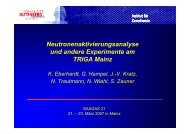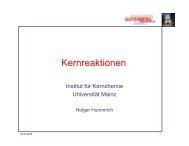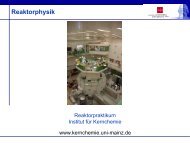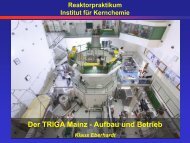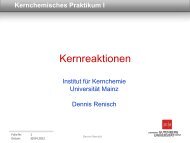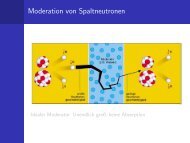jahresbericht 2007 - Institut für Kernchemie - Johannes Gutenberg ...
jahresbericht 2007 - Institut für Kernchemie - Johannes Gutenberg ...
jahresbericht 2007 - Institut für Kernchemie - Johannes Gutenberg ...
You also want an ePaper? Increase the reach of your titles
YUMPU automatically turns print PDFs into web optimized ePapers that Google loves.
SYNTHESIS, RADIOLABELLING AND EVALUATION OF<br />
N 5 -[ 18 F]FLUOROETHYL-PIRENZEPINE AND ITS METABOLITE<br />
N 5 -[ 18 F]FLUOROETHYL-RS 75<br />
Riss, Patrick 1 , Debus, Fabian 2 , Soskic, Vukic 3 , Schrattenholz, Andre 3 , Lueddens, Hartmut 2 ; Roesch, Frank 1<br />
1 <strong>Institut</strong> für <strong>Kernchemie</strong>, <strong>Johannes</strong> <strong>Gutenberg</strong>-Universität Mainz, 2 Psychiatrische Klinik und Poliklinik der Universität<br />
Mainz, 3 ProteoSys AG, Carl-Zeiss-Strasse 51, 55129 Mainz, Germany<br />
Introduction and aim: Pirenzepine 3, namely 11-[2-(4-<br />
methyl-piperazin-1-yl)-acetyl]-5,11-dihydrobenzo[e]pyrido[3,2-b][1,4]diazepin-6-one<br />
has originally been<br />
developed as M 1 selective muscarinic antagonist. Recently it<br />
has been shown[3] that 3 or its metabolite exhibit an unusual<br />
behaviour in vivo, that cannot be explained with M 1 antagonism.<br />
3 undergoes metabolism in vivo to form LS-75 4 5,11-<br />
dihydro-benzo[e]pyrido[3,2-b][1,4]diazepin-6-one. Compound<br />
4 was found to be a moderate inhibitor of PARP, an enzyme<br />
directly related to e.g. neuronal signal transduction and in particular<br />
to the regulation of key events in apoptotic cascades[3]<br />
Lesioned brain regions show an elevated concentration/activity<br />
of PARP-1, indicating links to neurodegenerative<br />
disorders. We were interested to investigate this second pirenzepine-related<br />
mode of action on a physiological level[2]. Our<br />
aim was to synthesise appropriate 18 F-fluorinated analogues of<br />
both compounds in order to provide the tools for an in vivo<br />
PET-study in healthy Sprague-Dawley rats of these potentially<br />
beneficial side effects of pirenzepine, which are beyond pure<br />
M 1 antagonism. In addition, the muscarinic acetylcholine receptor<br />
have been studied extensively with regard to its relation<br />
to several disorders including Alzheimers disease.<br />
F<br />
N<br />
HN<br />
O<br />
O<br />
N<br />
N<br />
N<br />
N<br />
N<br />
NH<br />
O<br />
N<br />
NCH 3<br />
1 2<br />
O<br />
N<br />
3 NCH 3<br />
4<br />
Fig. 1: parent compounds and fluoroalkylated congeners<br />
F<br />
N<br />
O<br />
HN<br />
O<br />
N<br />
NH<br />
and formulated in PBS prior to application. [ 18 F]-1 was isolated<br />
in a specific radioactivity of 12,5 MBq / nmol. For<br />
autoradiography, brain sections from adult, male Sprague-<br />
Dawley rats were used. Prior to incubation with radioligands,<br />
sections were pre-incubated in assay buffer (50 mM Tris/HCl<br />
buffer, pH 7.5, containing 120 mM NaCl). Nonspecific binding<br />
was determined using 100 µM of pirenzepine. Assay: Addition<br />
of 125 µl [ 18 F] 10 MBq/ml, 80 phosphate buffered saline.Incubation<br />
60 min in trisHCl-buffer (120 mmol NaCl) at<br />
pH 7.5, washed two times for 10 s, detection on storagephosphor<br />
over night.<br />
Results and Discussion: Both pirenzepine and its metabolite<br />
RS 75 have been prepared and labeled with 18 F via 2-<br />
[ 18 F]fluoroalkylation in position 5 of the benzodiazepinone<br />
moiety to obtain N 5 -[ 18 F]fluoroethyl pirenzepine and N 5 -<br />
[ 18 F]fluoroethyl LS 75. After autoradiographic evaluation,<br />
[ 18 F]-2 can now be evaluated in animal studies in vivo using<br />
Sprague-Dawley rats and a small animal PET scanner. [ 18 F]-2<br />
may be considered as a promising candidate for quantitative<br />
visualisation of PARP-1 distribution in rodent model.<br />
RCA / %<br />
50<br />
40<br />
30<br />
20<br />
10<br />
0<br />
0 5 10 15 20 25 30 35<br />
-10<br />
tim e / m in<br />
[18F]-1<br />
[18F]-2<br />
Fig. 2: Radiochemical yield as a function of time. Conditions: DMSO,<br />
K 2CO 3, 120 °C<br />
O<br />
F<br />
HN<br />
1. PPhe 3 , DEAD,<br />
2-fluoroethanol<br />
N<br />
O<br />
N<br />
NR<br />
R = H ; 4<br />
R = (4-methylpiperazinyl)acetyl; 3<br />
N<br />
N<br />
R<br />
R = H ; 2<br />
R = (4-methylpiperazinyl)acetyl; 1<br />
Methods: 4 was prepared from ethyl-2-amino-benzoate and 3-<br />
amino-2-chloro-pyridine. 3 was obtained by reacting 4 with 2-<br />
chloro acetic acid chloride followed by 4-methyl piperazine.<br />
Exposure to sodium ethoxide in ethanol yields sodium amides<br />
3a and 4a. Alkylation of 3 and 4 with 2-fluoroethanol under<br />
Mitsunobu conditions afforded reference compounds 1 and 2<br />
in yields of 95 and 90 % respectively. 3a and 4a have been labeled<br />
employing 2- [ 18 F]fluoroethyl tosylate. [ 18 F]-1 and [ 18 F]-<br />
2 were isolated by solid phase extraction, purified by HPLC<br />
Fig. 3: total binding (left) and specific binding (right) of [ 18 F]-1 in a<br />
coronal section of adult sprague-dawley rats<br />
References<br />
[1] U Holzgrabe, E Heller; Tetrahedron 59; (2003) 781–787<br />
[2] A Schrattenholz, V Soskic; Current Topics in Medicinal<br />
Chemistry 6 (2006), 663-686<br />
[3] Proteosys AG personal Communication<br />
- B17 -



